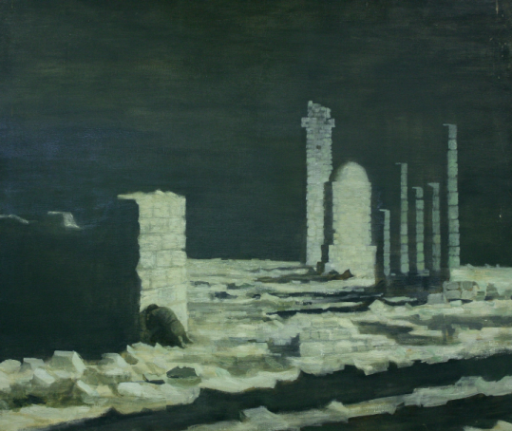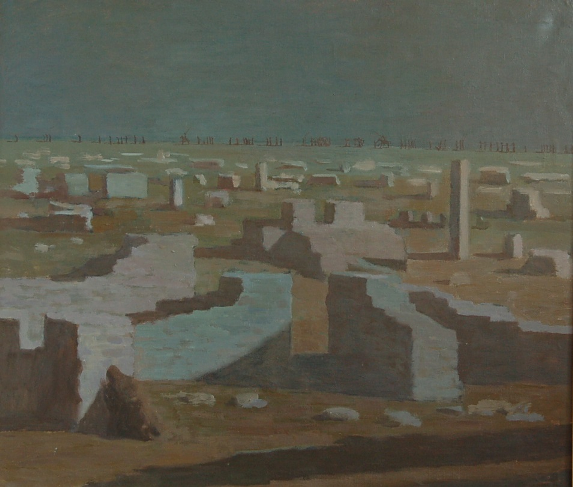Soltanov, Albert - VM - Viktor Barashkov
Albert Soltanov: Lamentations of Jeremiah

SOUNDS OF PAIN
by Viktor Barashkov
Works on religious themes from the Old Testament are uncommon in contemporary art. Yet there are some fundamental themes in this sacred text that intersect with our time, among them the Lamentations of Jeremiah. We have no famous Christian prophets now, but we have clear signs that not all is good in our world with people who have abandoned (or overlooked) God.
Russian artist Albert Soltanov is deeply concerned with the theme of the departure of the soul from the Lord. The book of Lamentations shows very vividly the feelings of the prophet Jeremiah about the history of the destruction of Jerusalem in 586 BC and the captivity in Babylon of people from the Kingdom of Judah. This is the subject of this work, which was created in 2003. At the moment it can be seen at the virtual exhibition of the 1st Biennale of Christocentric art (Russia). (https://christ-art.ru/en/works/)

The final composition was preceded by long preparation, evidence of which is the sketch of the painting. In the sketch we can see groups of people on the horizon being taken to Babylon. It seems that the chain of these people will never end. Their figures echo the rhythm of the ruins in the foreground. The diverse colour palette of these ruins gives us a narrative rather than an allegorical picture.
The final version is more minimalistic and centered on the figure of the prophet bowed against a massive column of layered stones at the bottom left of the picture. We see the broken stones of a once beautiful city illuminated only by the moon. The artist uses monochrome colours, focusing on the depiction of light and darkness. The contours of the objects are fuzzy, as if we see the picture with the eyes of a crying person – the eyes of Jeremiah himself. Columns of destroyed buildings seem to be calling out to the sky. The small figure of the prophet is lost among the ruins. Due to the depth of awareness of everything that has happened and his guilt, he does not have the spiritual strength to look at the light of the moon. Yet its light falls on him as a sign of hope:
So I say, “My splendor is gone
and all that I had hoped from the Lord.”
I remember my affliction and my wandering,
the bitterness and the gall.
I well remember them,
and my soul is downcast within me.
Yet this I call to mind
and therefore I have hope:
Because of the Lord’s great love we are not consumed,
for his compassions never fail.
They are new every morning;
great is your faithfulness.
I say to myself, “The Lord is my portion;
therefore I will wait for him.”
The Lord is good to those whose hope is in him,
to the one who seeks him;
it is good to wait quietly
for the salvation of the Lord.
Lamentations 3, 18-26 (NIV)
For Albert Soltanov this work is a warning: “When we forget God, nothing will remain but ruins. But people, even if they are close to God, tend not to listen to the prophets, not to notice their warnings, and then perhaps they do not even understand why something terrible has happened. And the prophets again and again have to grieve in the ruins...”
In this work the idea is expressed not only in colours, but also in sounds as Soltanov states: “When you read the Lamentations of Jeremiah and you feel how acute the pain sounds, you can almost physically feel it. What has been kept outside the picture itself tells us that despite the despair and the intensity of pain there is still hope, there is penitence and repentance.”
*******
Albert Soltanov: Lamentations of Jeremiah, 2003, oil on canvas, 110 × 119 cm, Private collection of the artist.
Albert Soltanov: Lamentations of Jeremiah, 2003 [sketch], oil on canvas, 70 × 80 cm, Private collection of the artist.
Albert Soltanov (b. 1974) is a Russian artist, who graduated from Surikov Moscow Art Institute in 2004. He works in various genres: landscapes, portraits, still lifes and historical paintings, but his favorite genre is landscape, because it gives him the possibility (in the artist’s own words) to “generalize, compress, concentrate scraps of momentary impressions, distant memories and hopes about the future”. He also works in church art and has mosaics in the Cathedral of St. Sava in Belgrade on Vračar (Serbia) and in the Church of the Ascension of the Lord at the Nikitsky Gate in Moscow and others. The works of Soltanov are in various museums in Russia and in private collections in Russia, Germany, Sweden, Turkey, South Korea, Norway and Finland. Read more (http://albertsoltanov.ru/)
Viktor Barashkov is a Russian philosopher and art historian. He is Assistant Professor at the Department of Philosophy and Religious Studies of Stoletovs’ Vladimir State University, Vladimir, Russia. The main fields of his interest are contemporary religious art and architecture, philosophy of culture and anthropology of religion. He is a member of the Russian National Section of the International Association of Art Critics (AICA).
ArtWay Visual Meditation 7 March 2021


